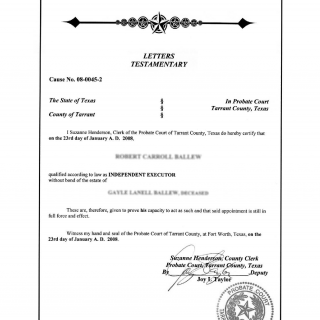Letter of Testamentary
A Letter of Testamentary is a legal document that grants an executor the authority to administer the assets and estate of a deceased person. The main purpose of this letter is to give the executor the power to act on behalf of the deceased person's estate and distribute assets to beneficiaries as per their will.
The document typically consists of the following parts:
- Introduction: This section identifies the deceased person, their date of death, and the court that issued the letter.
- Appointment of Executor: This section identifies the person who has been appointed as the executor of the estate.
- Powers of Executor: This section outlines the powers and duties of the executor, including the ability to manage and distribute assets, pay debts and taxes, and file legal documents.
- Bond: This section may require the executor to post a bond, which serves as a safeguard against any potential mismanagement of the estate.
- Signatures: The letter is signed by the court clerk, judge, or other authorized personnel.
Important fields to consider when writing a Letter of Testamentary include identifying the executor, identifying the beneficiaries, listing the assets of the estate, and outlining the distribution of assets. The letter typically requires supporting documents, such as a death certificate and the deceased person's will.
Examples of when a Letter of Testamentary may be necessary include when a deceased person had assets in their name alone, or when beneficiaries are disputing the distribution of assets.
Strengths of a Letter of Testamentary include providing a clear legal framework for the distribution of assets and providing the executor with the necessary authority to carry out their duties. However, weaknesses include potential delays in the court process and the requirement for the executor to post a bond.
Alternative forms to a Letter of Testamentary include a probate court order or informal probate. The main difference between these forms is the level of court involvement and oversight.
The Letter of Testamentary affects the future of the beneficiaries and the executor by providing a clear legal framework for the distribution of assets. It is typically submitted to the probate court in the county where the deceased person lived and is stored in the court's records.
How to Get a Letter of Testamentary
To get a Letter of Testamentary, you need to follow the legal process in the state or country where the deceased person lived. Here are the general steps to obtain a Letter of Testamentary:
- File a petition for probate: The executor or a family member must file a petition with the probate court in the county where the deceased person lived. The petition should include a copy of the death certificate, the original will, and any other necessary documents.
- Attend a hearing: The court will schedule a hearing to review the petition and determine if it is valid. The executor or petitioner must attend the hearing and present evidence to support the petition.
- Receive the Letter of Testamentary: If the court approves the petition, it will issue a Letter of Testamentary to the executor. The letter gives the executor the legal authority to manage and distribute the assets of the estate.
- Post a bond (if required): In some states, the court may require the executor to post a bond to ensure that they fulfill their duties and distribute the assets properly.
- Notify beneficiaries: The executor must notify all beneficiaries named in the will and any other interested parties of their appointment as executor and the probate process.
It is important to note that the process of obtaining a Letter of Testamentary can vary by state or country, and there may be additional requirements or steps involved. It is recommended to consult with an attorney who specializes in estate planning and probate law to ensure that you follow the proper legal process.

